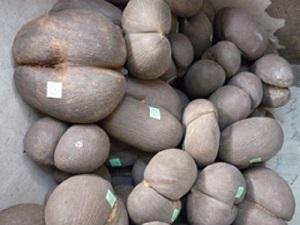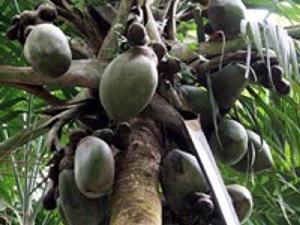Lucy Rist
This project aims to determine appropriate sustainable harvesting practices for Coco de Mer and to develop local capacity for population monitoring.

Nuts with permits ready for sale. ©Lucy Rist.
The Coco de Mer, Lodoicea maldivica, a unique palm endemic to the Seychelles, is famous for producing the largest seeds in the world. Deeply embedded in Seychellois culture the tree is renowned for its unusual biology, Coco de Mer palms live for between 200 and 400 years, the huge seeds taking up to 7 years to reach maturity. The Vallée de Mai, site of the largest Lodoicea population, is a principle tourist attraction, recognised internationally by its World Heritage Site designation. The Seychelles Island Foundation (SIF) manages the Vallée de Mai, and collects Lodoicea seeds, their sale to tourists providing an important source of income for conservation.

Coco de mer female. ©Christopher Kaiser-Bunbury.
The current intensity of seed collection may threaten the long-term viability of the palm population, a problem recognised by the SIF. With little knowledge on Lodoicea ecology and population dynamics, however, it is difficult to determine appropriate sustainable harvesting practices to secure its long-term viability as well as that of the revenue it generates. This project will provide a scientifically-informed assessment of sustainable harvesting intensities that also maximise income for conservation.
Extensive seed harvest data is already held by the SIF which requires collation and initial analysis. Additional field surveys will investigate population structure and regeneration potential, and a simple population dynamics model will be developed providing a preliminary indication of sustainable harvesting intensities. These assessments will be conducted alongside local SIF staff, including initial training in the relevant ecological techniques. The model will be used by the SIF to aid decision-making on harvest amounts and conservation strategies but will also serve as a basis for further investigation into sustainable harvesting of Coco de Mer and the development of longer-term management strategies for the Vallée de Mai.